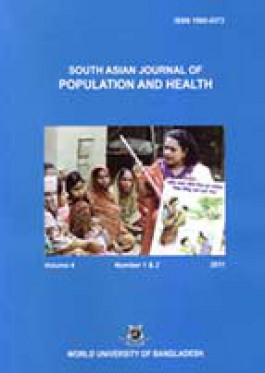
DETERMINANTS OF CHILD IMMUNIZATION IN BANGLADESH: AN ORDINAL LOGISTIC REGRESSION APPROACH
Written by: JAHIDA GULSHAN , ROWNAK JAHAN ARCHIE and AFRINA BHUIYAN
This paper aims to have a view of the immunization coverage and determinants of immunization coverage of under five children in Bangladesh using the Bangladesh Demographic and Health Survey-2007 data. Bivariate analysis is performed to determine association between immunization status and possible determinants followed by fitting an ordinal logistic regression model to assess the effects of those variables. Among the selected independent variables, mother’s occupation, mothers’ education, mother’s age, preceding birth interval, economic condition of household, region of residence, father’s education, number of children alive and division showed statistically significant association with immunization status.
THE STRUCTURAL CHANGES IN LIVELIHOOD STRATEGIES OF THE DEFORESTED VILLAGERS: A STUDY OF A VILLAGE IN NORTHERN-PART OF BANGLADESH
Written by: MD. FAKHAR UDDIN and SANJAY KRISHNO BISWAS
In Bangladesh we see that many villages are going with its traditional ways of livelihood for its betterment but in a deforested region traditional mode of livelihood do not exist. This study is carried out in a northern deforested village of Bangladesh. This paper explore the structural changes of people’s livelihood strategies through the explanation of socio-cultural condition, resources availability, past and present condition of some major resources and operational change in people’s living activities because of deforestation and other reasons. It also presents the important suggestion of the villagers to solve existing problematic situations. This study examines villagers’ perceptions, thoughts and attitudes. This study is a qualitative exploration where researchers use qualitative data collection techniques and tools such as In-depth interview, unstructured descriptive observation and so on.
SOCIO-ECONOMIC AND DEMOGRAPHIC DIFFERENTIALS IN FERTILITY PREFERENCES AND BEHAVIOUR IN BANGLADESH
Written by: MD. ISLAM UDDIN and SYEDA SANJIDA ISLAM
This paper examine the fertility preference and fertility behaviour in Bangladesh by desired number of children, children everborn and number of living children.The data for the study come from the 2007 Bangladesh Demographic and Health Survey(BDHS).The outcomes indicate that demand for high number of children is believed to be a major reason for high fertility levels in Bangladesh. The present study investigates the fertility preferences and fertility behaviour of the women, and how they vary with differences in their socio-economic and demographic characteristics in Bangladesh. The study found that despite the preferred family size (2.28) being quite high, it exceeded by the actual family size (2.77). The actual number of children the women who was not a product of her personal choices and decision alone but an outcome of interaction among a complex set of factors, including social, cultural, economic, religious and demographic aspects of life. The factors that affected the fertility preference and behaviour most were the educational level of the women, and her preferred number of sons. Based on the findings of the study, this study suggests an emphasis on female education and promotion of gender equity as means to lower the existing high levels of fertility in the country.
NUTRITIONAL KNOWLEDGE, SANITARY AND HYGIENE PRACTICE OF THE UNMARRIED ADOLESCENT GIRL IN A SLUM OF DHAKA CITY
Written by: NAFIS MD. IRFAN and MD. AMINUL HAQUE BHUYAN
A descriptive study was carried out among 80 unmarried adolescent girls living in a slum of Dhaka city. The objective of the study was to assess the nutritional knowledge, sanitary and hygiene practice among them. The result shows that around 38% of the respondents were in class 1-5. Most of the respondent’s father works at shop (25%) while majority of the mothers (77.5) were house wife. Only 1.2% and 8.8%of the respondents had correct knowledge about exclusive breast feeding and colostrum feeding. Only 15%, 7.5% and 20% of the adolescent girls answered that they had correct knowledge about energy yielding, body building and body protecting food respectively. The overall sanitary and hygiene practice was not good among respondents. 88.8% respondent washed hands before eating, while 73.8% respondents washed hands before cooking in food preparatory phase. Only 63.8



